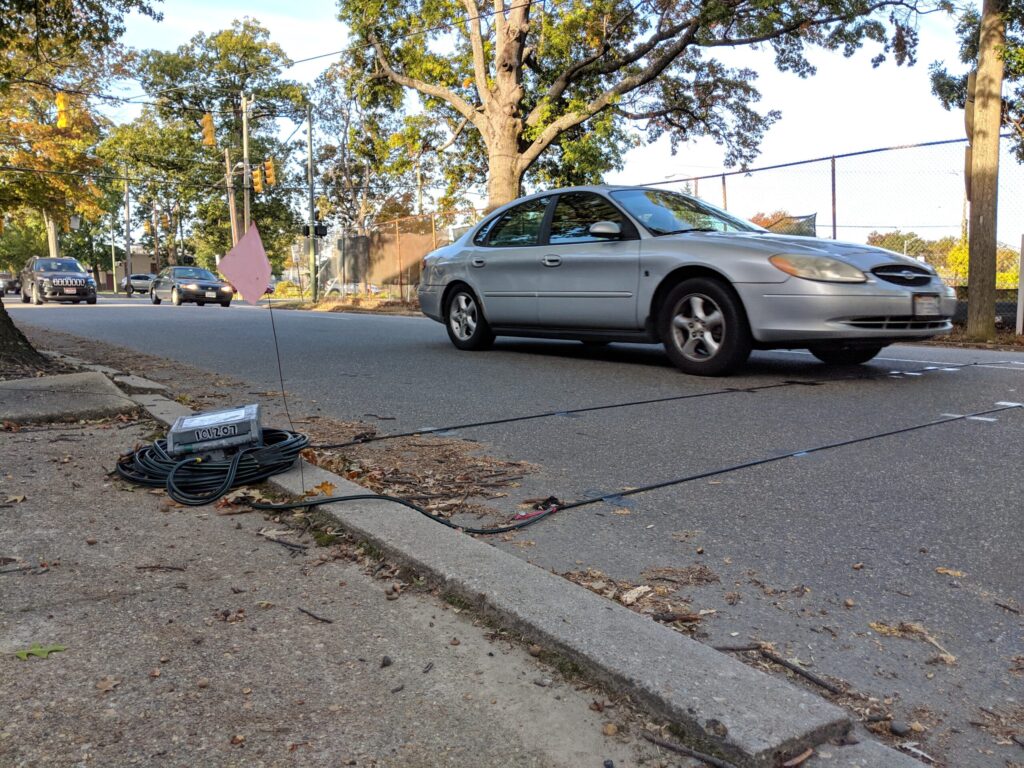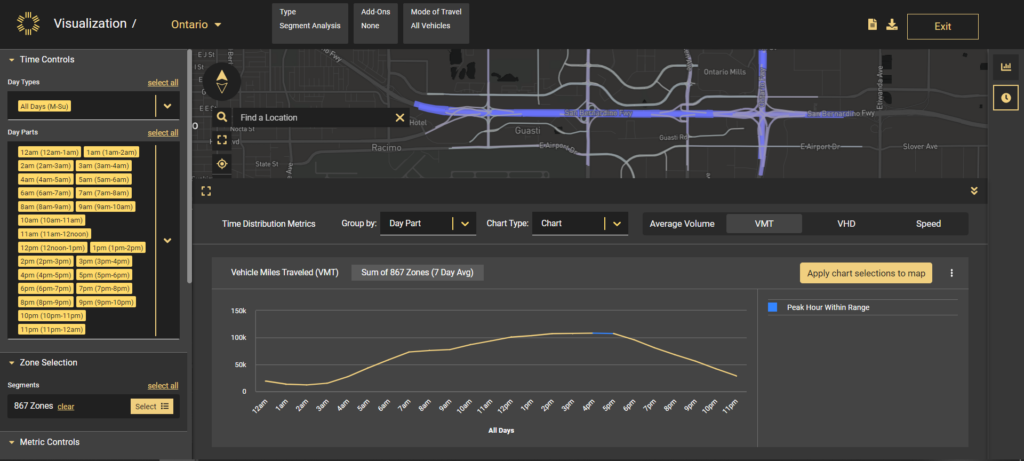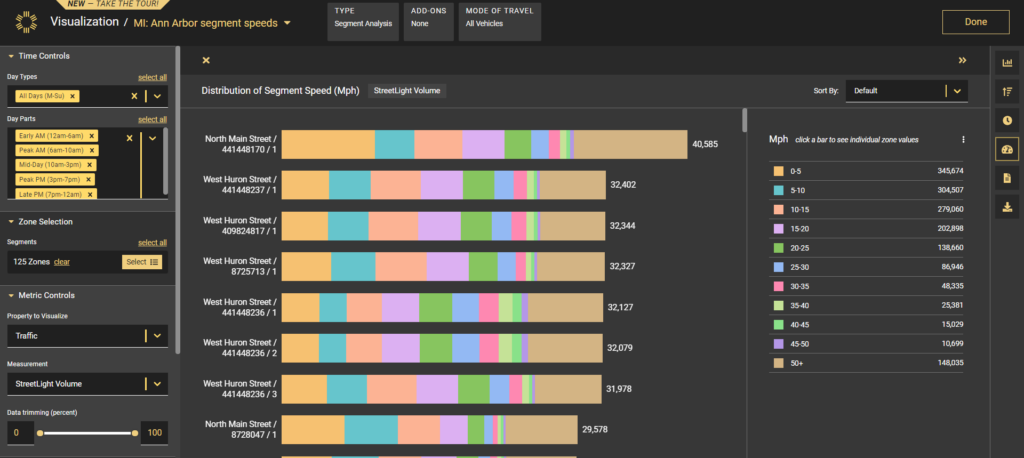Corridor Studies Explained: What they are and how analytics make them quicker and cheaper
Corridor studies create crucial insights that keep people and goods moving safely, but they also demand ample resources from agencies already grappling with budget and staff limitations. On-demand analytics streamline data collection, offering a quicker and less costly path to the insights that inform corridor improvements.

Jump Ahead
See how on-demand analytics streamline corridor studies & clarify planning priorites
When it comes to mobility, not all roads are created equal. That’s why transportation professionals devote considerable time and resources to major corridors — like interstates, state routes, and other major thoroughfares — to ensure people and goods can get where they need to go safely and efficiently.
To understand how mobility can be improved or maintained along these major arteries of travel, corridor studies are essential. They enable transportation professionals to understand existing conditions, project future conditions, prioritize improvement projects, earn stakeholder and public buy-in for these projects, and ensure environmentally-friendly transportation systems.
These outcomes are so important that corridor studies are often required under federal and state regulations before transportation projects can be approved or funded. But these studies are also demanding, unwieldy, and time-consuming for those who carry them out. They typically take several months or even years to complete, which can deplete already-thin agency budgets and frustrate constituents who want to see action.
So what is a corridor study exactly, why are these studies so important, how are they conducted, and how can technological innovations help shorten timelines, lower costs, earn stakeholder buy-in on projects, and deliver a fuller picture of corridor connectivity? We explore all these questions below.
What is a corridor study?
A corridor study is a planning project that aims to characterize existing and future roadway conditions along a major connective roadway (i.e., corridors) used by vehicles, bicycles, transit, and pedestrians. The scope of a corridor study may be hyper-local (a few miles or less) or it may account for dozens of miles of roadway, as is often the case when studying a major interstate.

Corridor studies are often multi-purpose projects that support a wide range of transportation goals such as:
| Improving Operations | Economic Growth & Stability | Sustainability & Resilience | Safety & Equity | Communication & Public Relations | Meeting Regulatory Requirements |
|---|---|---|---|---|---|
| Estimating roadway capacity | Accommodating freight movement | Ensuring resilience against climate change, natural disasters, and general deterioration | Revealing safety concerns and potential improvements | Gaining community buy-in for proposed projects | Satisfying regulatory requirements for a project that is already planned for a funding cycle |
| Diagnosing and improving congestion and Level of Service (LOS) | Promoting tourism | Quantifying and minimizing the environmental impact of travel | Addressing inequitable infrastructure | Minimizing impacts to the traveling public during implementation | Estimating costs of maintaining or improving a corridor |
| Developing a travel demand model to help forecast future travel conditions | Expanding multimodal access and designing Complete Streets | Assisting other transportation agencies like MPOs and RPOs in identifying future projects along a corridor |
To encourage a transparent planning process with buy-in from the public and other stakeholders, study findings and recommended projects are typically shared with partners, regional governments, advocacy groups, and the public through a published report.
Long-Range Corridor Plans
This type of corridor plan typically studies a major interstate or other highway and aims to establish justification for upcoming improvements, which may be implemented at a much later date (sometimes 10 or more years after the plan is created). In many cases, the plan is designed to address requests tied to political interests.
Long-range corridor plans are often conducted on a recurring basis (e.g., every 10 years or so) to keep up with shifting travel demand and offer guidance to DOTs, MPOs, RPOs, and other stakeholders who may design or carry out corridor improvements recommended by the plan.
NEPA Corridor Plans
The National Environmental Policy Act (NEPA) requires federal transportation agencies to report on the environmental impact of proposed projects, such as the construction of highways and other publicly-owned facilities. These reports must include an exploration of alternatives to demonstrate why the project proposed is the best available option.

A NEPA corridor plan is usually established once a project and set of projects along a corridor has been planned for a funding cycle (to be funded within 10 years). As part of the planning process, public review must be sought out and incorporated in order to satisfy NEPA requirements so that funding can move forward and projects can be implemented.
Sometimes projects are put on hold and the NEPA process languishes. In this case, when it is restarted, NEPA needs to be revisited along with any updates to existing conditions and forecasts. This is particularly true when a large funding stream becomes available.
Metropolitan Corridor Plans
MPOs regularly plan for network and corridor improvements in their region as part of their Metropolitan Transportation Plan (MTP). These corridor plans are often ongoing and evaluate many iterations of projects and project portfolios in their MTP.
If a project is not indicated with dedicated funding in a MTP, then it can’t receive federal dollars. MTPs are made for rolling 20-year periods and updated every five years.
While MTPs are typically managed and developed internally by large MPOs, AEC firms may be contracted to assist with planning and coordinating public involvement. AEC firms or research institutes may also assist in modeling and data collection. Project funding and later activities are typically provided by the state.
City/County Corridor Plans
A city DOT or Planning Department will also initiate more localized corridor planning activities. These may be done in coordination with the MTP, federal, and state funding processes or as part of local funding efforts. As with other types of corridor plans, AEC firms are often called upon to help with the planning process and public outreach.
These projects often support goals related to Complete Streets, access management, economic growth, safety, traffic signals, and local transit.
Streamline corridor analysis with on-demand metrics like VMT, VHD, Trip Speed, and more
Get StartedHow is corridor study data collected?
In order to evaluate existing conditions and forecast travel demand on a corridor, a wide range of data must be collected. Traffic volumes for all vehicles, as well as bicycles and pedestrians, are just the beginning. Turning Movement Counts (TMC) at intersections, Origin-Destination (O-D) patterns showing how travelers use the corridor to get from point A to point B, and congestion metrics may also be collected. Additionally, analysis will typically include estimating LOS, VHD, VMT, Crash Rates, and Reliability Indexes.
Traditional data collection methods for corridor studies include:
- Field observations
- Staff are sent out to multiple locations along the corridor to collect roadway inventory and measure geometries
- Roadway sensors
- Sensors collect traffic counts, speeds, and turning movements
- Crash reports
- Existing crash report data is reviewed and used to derive crash rates and flag safety issues
- Data from previous transportation studies
- Past studies of the corridor are reviewed for additional insights and can help demonstrate change over time

Because of the time and cost that goes into many of these traditional methods, transportation analytics are often used to supplement and streamline these measurements. Given the difficulty of collecting data across a large area — such as traffic counts for a whole interstate — not only do analytics save time and money, but they also allow transportation professionals to get a consistent snapshot of a corridor at the same point in time and from different perspectives. Multiple analyses can be run in minutes, and data can easily be segmented by factors like time of day or day of week.
Despite these advantages, analytics typically do not replace traditional methods entirely. For example, in order to assess conditions such as roadway geometry, guiderail erosion, and sight distance, manual field observations are often necessary. However, software-based analytics are often indispensable in deriving data like Vehicle Miles Traveled (VMT), TMC, VHD, and O-D patterns for a corridor.
Input from stakeholders and the public is also gathered during the study. This helps identify community priorities, provide insight into who the corridor serves, and inform viable projects. Since getting the public on board with upcoming projects is a key concern for corridor planners, these insights are crucial for developing data-backed recommendations that justify proposed plans.
The data that is collected may also be used to build travel demand models that help forecast future conditions along the corridor.
How analytics are making corridor studies easier and more complete
Because corridor studies combine so many elements and may inform decades of infrastructure projects, they often take months to years to complete, demanding considerable cost and effort along the way.
While total study costs vary dramatically based on the size of the corridor, hundreds of thousands of dollars are typically devoted to the process. For example, a 2020 corridor study by VDOT studying under three miles of roadway cost $100,000[1], while a study of just 4.7 miles of SR 303 in Bremerton, Washington, was budgeted at $500,000.[2] Corridor studies often cover much larger areas than these two examples, and thus costs escalate quickly.
Although certain data must be collected manually in the field, software-based transportation analytics can significantly streamline data collection, while providing a more holistic account of roadway conditions like traffic volume, congestion, O-D, and turning movements. Because historical data can be accessed on demand for any day of the week, time of day, or month of the year, these analytics offer a more complete view of roadway conditions than temporary sensors or manual field observations gathered over just a few days.

Additionally, on-demand analytics contribute to a more holistic understanding of roadway safety. Traditional safety analyses rely heavily on information from reported crashes, missing nuances from crashes which may not be reported and unsafe incidents which don’t result in crashes. This can provide an incomplete view of factors contributing to unsafe corridors and make it more challenging to pinpoint sections of roadway where safety improvements could make the biggest impact. But when corridor studies incorporate transportation analytics, factors like speed, bike and pedestrian activity, and turning movements by time of day or day of week can provide additional insight to inform safety solutions.

By incorporating Census data to overlay aggregated demographic info on other corridor data, on-demand analytics also assist planners and engineers in identifying existing inequities and proposing improvements that address these disparities so that corridors serve everyone. Traditional methods of data collection miss out on this equity lens, making it harder for transportation professionals to ensure equity-first infrastructure.
For example, a steering committee conducting a corridor study of PA Route 28 used StreetLight InSight® to analyze the geographic spread of the home locations of travelers, helping reveal who the corridor serves. The committee also leveraged StreetLight to understand trip purpose, O-D patterns, trip duration, and trip speed.[3] Another study of seven key corridors in Hartford, Connecticut, used StreetLight InSight® to collect travel patterns, including O-D and trip volumes by time of day.[4]
And analytics don’t just help with establishing existing conditions. Because of the additional nuance and granularity provided by on-demand analytics, this technology is also a boon for modelers looking to build complex travel demand models that help forecast future roadway conditions.
Additionally, analytics platforms can assist with NEPA plans by helping estimate emissions, reveal EV activity, and measure overall traffic on a corridor.
Finally, platforms like StreetLight InSight® assist planners in justifying proposed corridor projects to stakeholders and the public through data visualizations that put study findings into perspective.
So while analytics can’t replace the need for certain manual measurements and field observations, they can justify prioritization decisions for stakeholders and the public with validated data while saving time and money on data collection and modeling so transportation agencies can devote more time to designing and implementing safe, resilient, and well-operated corridors for all.
- Virginia Department of Transportation, Shreve Road Corridor Study. December 2020.
- Washington State Department of Transportation, SR 303 Corridor Study. May 2021.
- Southwestern Pennsylvania Commission, Route 28 Corridor Study. November 2020.
- Connecticut Department of Transportation, Greater Hartford Mobility Study Existing Conditions Report. December 20, 2021.

WEBINAR: See how on-demand analytics streamline corridor studies & clarify planning priorities
Watch NowReady to dive deeper and join the conversation?
Explore the resources listed above and don’t hesitate to reach out if you have any questions. We’re committed to fostering a collaborative community of transportation professionals dedicated to building a better future for our cities and communities.